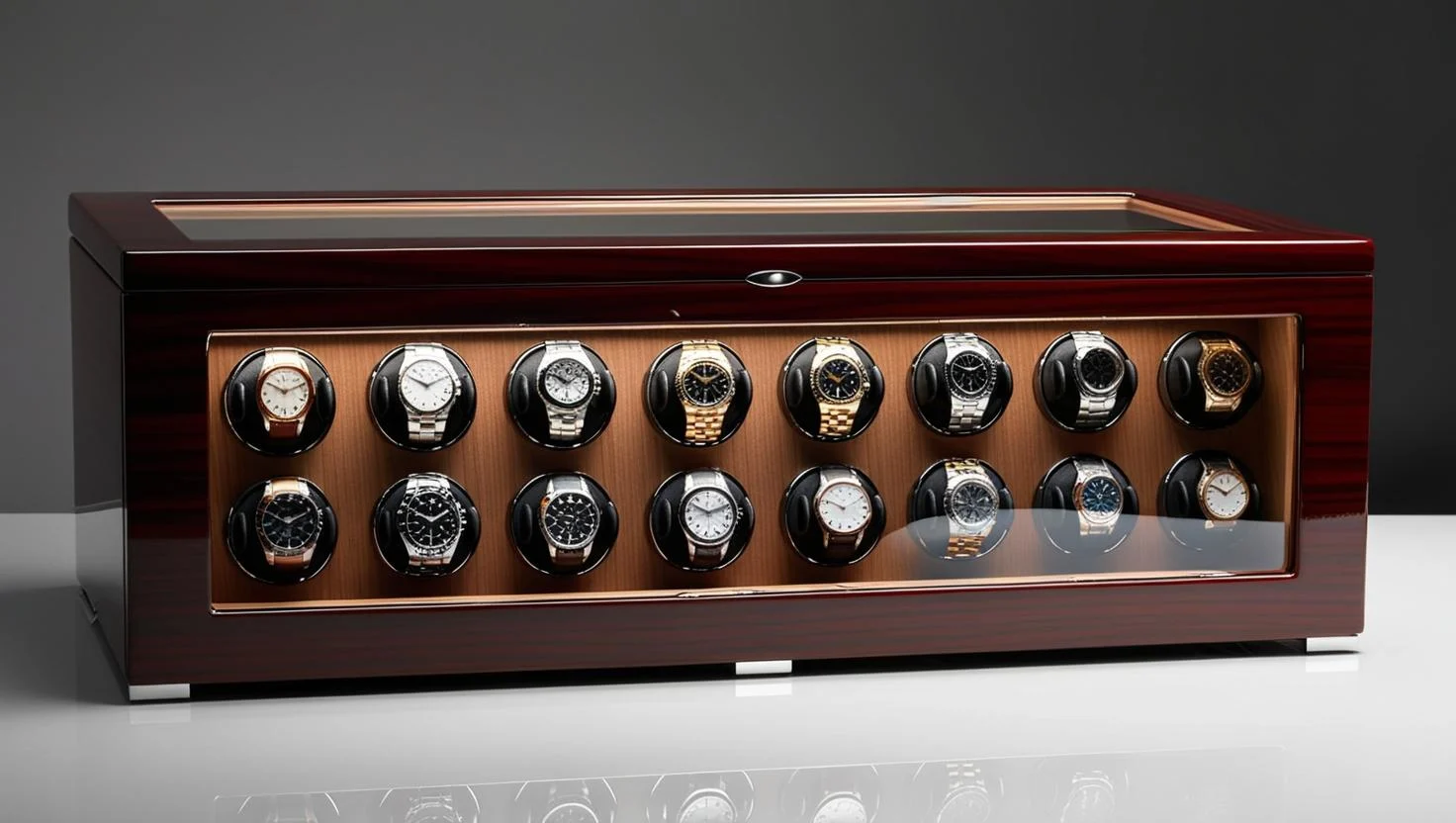Owning a luxury watch is more than a statement of style; it is an investment in craftsmanship, history, and personal legacy. To maintain the value and functionality of your treasured timepieces, proper care is paramount. One essential tool in any collector’s arsenal is a watch winder, which not only preserves the mechanisms of automatic watches but also extends their lifespan. In this guide, we’ll delve into how watch winders work, their benefits, and how to choose the best one for your collection.
Table of Contents
What Is a Watch Winder?
A watch winder is a device designed to keep automatic watches wound when not being worn. Automatic watches rely on the motion of the wearer’s wrist to power their movement. Inside the watch, a rotor swings with wrist movement, transferring energy to wind the mainspring. When a watch is idle for an extended period, it stops functioning, which can affect its accuracy and internal lubrication.
A watch winder simulates the motion of the wrist, ensuring the watch continues to operate smoothly. The device rotates the watch in pre-set patterns, maintaining its power reserve and protecting its intricate components.
The Benefits of Using a Watch Winder
Maintaining Movement Accuracy
Automatic watches depend on constant movement to maintain their precision. When left idle, the oils inside the movement can thicken or settle unevenly, leading to inaccurate timekeeping. A watch winder prevents this by ensuring the watch is always in motion.
Protecting Internal Mechanisms
The intricate gears and levers inside a luxury watch require regular motion to prevent wear and tear. A watch winder minimizes the risk of damage caused by inactivity, such as dried lubrication or stagnant components.
Convenience for Multi-Watch Owners
For collectors, manually winding and resetting multiple watches can be time-consuming. A watch winder eliminates this hassle by keeping each piece ready to wear, complete with accurate time and date settings.
Enhancing Longevity
Continuous operation prevents strain on the movement that might occur when restarting a stopped watch. By reducing manual winding, a watch winder extends the overall lifespan of your timepieces.
Choosing the Right Watch Winder for Your Collection
Determine Your Collection’s Needs
The first step in selecting a watch winder is understanding the requirements of your collection. Consider the following:
- Number of Watches: Choose a single-watch or multi-watch winder based on your collection size.
- Watch Size and Weight: Ensure the winder can accommodate larger or heavier timepieces, which are common in luxury collections.
- Winding Direction: Check whether your watches require clockwise, counterclockwise, or bidirectional winding.

Evaluate Build Quality
A high-quality watch winder is a worthwhile investment. Look for features such as:
- Durable Materials: Opt for wood, leather, or metal finishes that complement your collection.
- Silent Motors: A reliable winder operates quietly, avoiding distractions in your space.
- Soft Watch Holders: Cushioned mounts protect your watches from scratches and wear.
Examine Customization Options
Premium watch winders offer adjustable settings to suit different watches:
- Winding Programs: Choose winders with customizable rotations per day (TPD) to match your watch’s specifications.
- Power Options: Dual power modes (battery and AC adapter) provide flexibility in placement.
Prioritize Aesthetic Appeal
As part of your luxury collection, a watch winder should match your style. Many brands offer elegant designs that double as display cases, enhancing the visual appeal of your collection.
Click here to find your preferred watch winder on Amazon
Top Tips for Using a Watch Winder
Follow Manufacturer Guidelines
Each watch comes with specific winding requirements. Always consult your watch’s manual to ensure the winder is set to the correct rotation and TPD.
Clean Your Watch and Winder Regularly
Dust and dirt can accumulate on your watch and inside the winder. Clean both surfaces periodically to maintain their pristine condition.
Monitor Long-Term Performance
While a watch winder reduces maintenance needs, it’s essential to have your watches serviced professionally every few years. Regular check-ups keep the internal mechanisms in top shape.
Common Myths About Watch Winders
Common Myth 1: “A Watch Winder Overwinds Watches”
Modern watch winders are equipped with mechanisms that stop winding once the power reserve is full. This prevents overwinding and ensures safe operation.
Common Myth 2: “All Watch Winders Are the Same”
Not all winders are created equal. Investing in a quality winder tailored to your collection’s needs is crucial for effective performance.
Common Myth 3: “Watch Winders Are Unnecessary”
While some collectors prefer manual winding, watch winders save time, maintain accuracy, and protect valuable pieces from long-term damage.
Also Read: The Best Casio Watches for Collectors: Top 5 Picks
Investing in the Right Watch Winder
A watch winder is not merely an accessory; it’s a vital tool for preserving the value and functionality of your luxury watches. By choosing a high-quality winder tailored to your collection, you can ensure your timepieces remain in pristine condition for years to come.
If you’re serious about protecting your investment, a watch winder is indispensable. Explore reputable brands and models, and consider factors like build quality, aesthetics, and functionality when making your choice.
FAQ’s
What is the purpose of a watch winder?
A watch winder keeps automatic watches wound and operational when not in use. It simulates wrist movements to maintain the watch’s power reserve and accuracy.
Do all automatic watches need a watch winder?
While not strictly necessary, a watch winder is highly beneficial for maintaining accuracy, protecting internal mechanisms, and reducing the effort required to reset the time and date.
How do I choose the right watch winder for my collection?
Key factors to consider include the number of watches, watch size and weight, winding direction, and desired customization options like adjustable rotations per day (TPD).
What are the benefits of using a watch winder?
Maintains movement accuracy
Protects internal components
Saves time for multi-watch owners
Enhances the longevity of watches
Do watch winders replace professional servicing?
No, while a watch winder helps maintain functionality, it does not replace regular professional servicing. Periodic maintenance is still essential for long-term performance.
What happens if I don’t use a watch winder for my automatic watch?
If an automatic watch is left idle for too long, it may stop functioning. Over time, this can affect the accuracy of the movement and cause the internal oils to settle unevenly, potentially leading to wear.
Are there alternative ways to keep my automatic watch wound?
Yes, you can manually wind your watch or wear it regularly to keep it operational. However, a watch winder is a convenient solution for maintaining multiple watches.
Feel free to explore watch winders tailored to your needs and enjoy the peace of mind they offers for your valuable collection!







